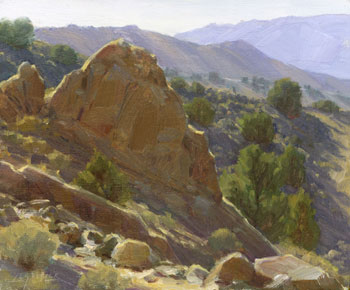 |
Jean LeGassick "Emerging From Shadow" oil on canvas on board "10" x "12" 2004 |
On the Ground and in the Open Air
Jean LeGassick’s paintings tend to be smaller, oil-on-board works versus the canvas that Nicholson favors. Her brushstrokes are more evident and her surface textures engaging. She is a determined empiricist, painting from vantage points often obtained through hours of hiking in less than ideal conditions. As a result, her work has an exceptional immediacy to the light present at the time.
LeGassick’s view of an outcrop near Virginia City, “Emerging from Shadow,” is a scene she paints repeatedly in different seasons, time of day, and atmospheric conditions, a practice she relates directly to Monet’s serial paintings of haystacks. Although we at first may take the subject to be the outcrop itself—as if it were the car in Nicholson’s painting—what captures your attention after first glance are the variety of shadows cast by the rock and the piñon-juniper woodland. It is not always what is most obvious in the desert that ends up forming your lasting impressions.
Ron Arthaud pushes paint around with the strongest hand of the three, and is openly concerned with how the eye travels over the surface of the art as well as the landscape. Whether painting long vistas or an intimate portrait of a fence in snow, his brushstrokes become individual optical phenomena held together only by the force of composition. Encountering an Arthaud painting is to see how the mind assembles the world out of what could easily be an inchoate mass of color and light.
Snow, that counterintuitive condition for a desert, doesn’t register easily with the eye. It’s too bright and too extreme in its color shifts for us to focus on for long. We have trouble, as a result, in remembering how blue it makes shadows, and how it pumps up contrast with objects. Arthuad’s painting of a “buried” fence counterpoises its wooden stakes with the live wood at its end. It is not only a study of how such extreme light functions, but a metaphor of places abandoned and left to their own devices. That, too, is part of the Great Basin, a region that has seen more than five hundred towns disappear during the last hundred and forty years.
The artists of the Great Basin Gallery carry forth a landscape tradition that has long been fundamental in America to our understanding of where we live, and how we make sense of the land around us. The residents of Northern Nevada are fortunate to live with a venue that nurtures those artists, and to in turn be so well nourished by them. And that symbolizes how the land itself takes care of its citizens. These three artists make transparent for us that vital matter.
William L. Fox
Southern California
December 2005